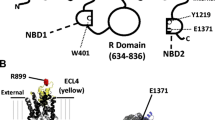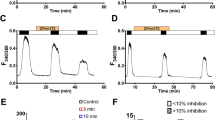Cystic fibrosis transmembrane conductance regulator (CFTR) is a protein kinase A (PKA) and ATP regulated Cl- channel. Studies using mostly ex vivo systems suggested diphenylamine-2-carboxylate (DPC), 5-nitro-2-(3-phenylpropylamino) benzoic acid (NPPB) and glybenclamide inhibit CFTR Cl- conductance (CFTR GCl). However, the properties of inhibition in a native epithelial membrane have not been well defined. The objective of this study was to determine and compare the inhibitory properties of the aforementioned inhibitors as well as the structurally related anion-exchange blockers (stilbenes) including 4,4'-diisothiocyanatostilbene-2,2'-disulfonic acid (DIDS), 4-acetamido-4'-isothiocyanatostilbene-2,2'-disulfonic acid (SITS), 4,4'-dinitrostilbene-2,2'-disulfonic acid (DNDS) in the microperfused intact and basilaterally permeabilized native sweat duct epithelium. All of these inhibitors blocked CFTR in a dose-dependent manner from the cytoplasmic side of the basilaterally permeabilized ducts, but none of these inhibitors blocked CFTR GCl from the luminal surface. We excluded inhibitor interference with a protein kinase phosphorylation activation process by "irreversibly" thiophosphorylating CFTR prior to inhibitor application. We then activated CFTR GCl by adding 5 mM ATP. At a concentration of 10?4 M, NPPB, DPC, glybenclamide, and DIDS were equipotent and blocked ~50% of irreversibly phosphorylated and ATP-activated CFTR GCl (DIDS = 49 ± 10% > NPPB = 46 ± 10% > DPC = 38 ± 7% > glybenclamide = 34 ± 5%; values are mean ± SE expressed as % inhibition from the control). The degree of inhibition may be limited by inhibitor solubility limits, since DIDS, which is soluble to 1 mM concentration, inhibited 85% of CFTR GCl at this concentration. All the inhibitors studied primarily blocked CFTR from the cytoplasmic side and all inhibition appeared to be independent of metabolic and phosphorylation processes.
Similar content being viewed by others
Author information
Authors and Affiliations
Corresponding author
Additional information
An erratum to this article is available at http://dx.doi.org/10.1007/s00232-006-1003-4.
Rights and permissions
About this article
Cite this article
Reddy, M., Quinton, P. Effect of Anion Transport Blockers on CFTR in the Human Sweat Duct. J Membrane Biol 189, 15–25 (2002). https://doi.org/10.1007/s00232-001-0192-0
Received:
Issue Date:
DOI: https://doi.org/10.1007/s00232-001-0192-0




